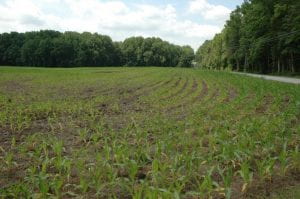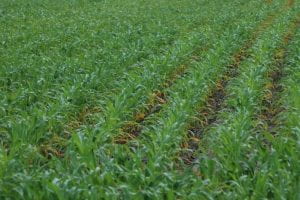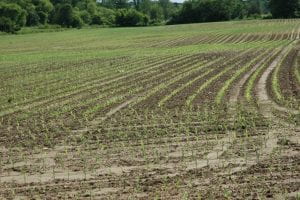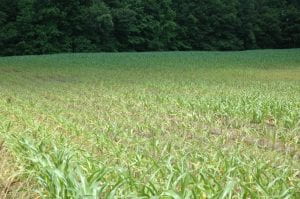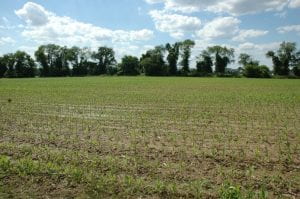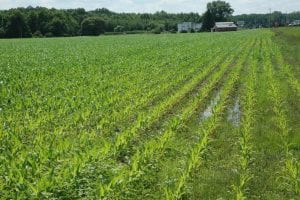Richard Taylor, Extension Agronomist; rtaylor@udel.edu
As a follow-up article to my article last week, I thought I should review what I’m seeing a lot of in northern Delaware and southern New Jersey.
When you look at many of the fields of corn in the northern part of Delaware and southern New Jersey, the impact of denitrification is readily visible (Photos 1-6). Many fields are showing typical N chlorosis symptoms that indicate that most, if not all, of the soil available nitrate-N has been lost as N2, NO or N2O gas. In some cases, the economic loss of N was minimal as the growers applied only small amounts of N as starter. However in other cases the amount of applied N was much greater and done to allow greater flexibility in the timing of sidedress N. In other cases, not only was commercial fertilizer as urea ammonium nitrate solution (UAN) applied but past efforts at building soil organic matter had been expected to add to the timing buffer via the effect of soil organic matter mineralization. In still other cases where growers were successful in planting corn early, sidedressed N application could have taken place before the last period of heavy rain.
The unusual weather pattern of 2013 (cold, followed by cold and wet, followed by dry and hot, and then this last period of moderate temperatures and heavy rainfall) led to slow mineralization of soil organic matter but complete denitrification of any soil N that had been mineralized and nitrified. In addition, in those fields that had been sidedressed with UAN early, a substantial portion of the urea and ammonium that had been nitrified to nitrate-N could have been lost to denitrification. The difficulty now will be getting on these wet fields with either sidedress N or additional N before the lack of N lowers the corn’s yield potential.
At this point in the growing season, we all probably wish for a crystal ball to tell us how much N remains in the soil, what the weather will be like for the rest of the growing season, how best to get N on our crops, and a host of other questions. Unfortunately, that type of crystal ball just doesn’t exist and the answers will likely vary from field to field. Each grower or consultant will need to evaluate the individual fields and try to make the best guess possible as to what needs to be done to produce the maximum economic return from each field. As a guide, you should keep in mind that N is a mobile element. What this means is that the plant will cannibalize the N from the older, lower leaves first and send that to either the growing point or later, after silking and pollination, to the grain that is being filled. The severity of N deficiency can to some degree be estimate by how many corn leaves on a plant are showing N deficiency symptoms. The more leaves affected the greater the severity.
Another question often asked is how much of the required N is taken up by the crop by a particular growth stage. An Iowa State Extension Special Report No. 48, “How a Corn Plant Develops”, by Ritchie, Hanway, and Benson indicates that by tassel emergence to silking about 60 to 70% of the uptake of N has occurred with two thirds of the 60% taking place between V10/V12 and tassel emergence (R1). For potassium (K), about 90% of K uptake is completed by R1 with almost all of that occurring between V6 and R1. Phosphorus, on the other hand, has a steady and almost linear uptake that is not complete until after R5 (dent stage).
Again from a nutrient management viewpoint, you need to consult with you nutrient management plan writer to be sure your plan is modified for this year’s unusual weather. In addition to the proposed changes in your N management plan, be sure your plan writer includes the justification for the additional N you may need to apply to corn this year.
Photos 1 – 6 below are illustrative of the impact of denitrification loss of N on corn in southern New Jersey (June 2013, Photos by R. Taylor).

